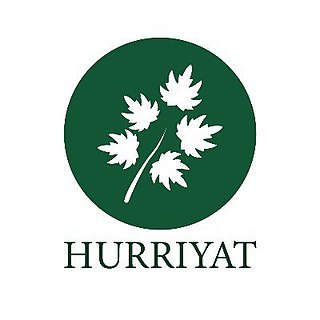
All Parties Hurriyat Conference (APHC) is an alliance of 26 political, social and religious organizations formed on 9 March 1993, as a united political front to raise the cause of Kashmiri independence in the Kashmir conflict. Mehmood Ahmed Saghar was the first convener of the APHC-PAK chapter when the alliance was established in 1993. The alliance has historically been viewed positively by Pakistan as it contests the claim of the Indian government over the State of Jammu and Kashmir. The organisation is split into two main factions, those being the Mirwaiz and Geelani factions. Mirwaiz Umar Farooq is the founder and chairman of Mirwaiz faction and Masarat Alam Bhat is the interim chairman of Geelani faction, who succeeded Syed Ali Shah Geelani, the founder of the faction after his death.
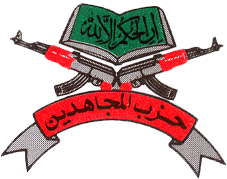
Hizbul Mujahideen, also spelled Hizb-ul-Mujahidin, is a Pakistan-affiliated Islamist militant organisation that has been engaged in the Kashmir insurgency since 1989. It aims to separate Kashmir from India and merge it with Pakistan, and is thus one of the most important players in the region as it evolved the narrative of the Kashmir conflict by steering the struggle away from nationalism and towards jihadism.

Operation Grand Slam was a key military operation of the Indo-Pakistani War of 1965. It refers to a plan drawn up by the Pakistan Army in May 1965, that consisted of an attack on the vital Akhnoor Bridge in Jammu and Kashmir, India. The bridge was not only the lifeline of an entire infantry division of the Indian Army, but could also be used to threaten the city of Jammu, an important logistical point for Indian forces. The operation saw initial success, but was aborted when the Indian Army opened a new front in the Pakistani province of Punjab in order to relieve pressure in Kashmir. This forced Pakistan to abandon Grand Slam and fight in Punjab, thus the operation ended in failure and the stated objectives were not achieved.

The Jammu Kashmir Liberation Front (JKLF) is a formerly armed, political separatist organisation active in both the Indian-administered and Pakistani-administered territories of Kashmir. It was founded by Amanullah Khan, with Maqbool Bhat also credited as a co-founder. Originally a militant wing of the Azad Kashmir Plebiscite Front, the organization officially changed its name to the Jammu Kashmir Liberation Front in Birmingham, England on 29 May 1977; from then until 1994 it was an active Kashmiri militant organization. The JKLF first established branches in several cities and towns of the United Kingdom and other countries in Europe, as well as in the United States and across the Middle East. In 1982, it established a branch in the Pakistani-administered territory of Azad Jammu and Kashmir, and by 1987, it had established a branch in the Indian-administered Kashmir Valley.

The Kashmir conflict is a territorial conflict over the Kashmir region, primarily between India and Pakistan, and also between China and India in the northeastern portion of the region. The conflict started after the partition of India in 1947 as both India and Pakistan claimed the entirety of the former princely state of Jammu and Kashmir. It is a dispute over the region that escalated into three wars between India and Pakistan and several other armed skirmishes. India controls approximately 55% of the land area of the region that includes Jammu, the Kashmir Valley, most of Ladakh, the Siachen Glacier, and 70% of its population; Pakistan controls approximately 30% of the land area that includes Azad Kashmir and Gilgit-Baltistan; and China controls the remaining 15% of the land area that includes the Aksai Chin region, the mostly uninhabited Trans-Karakoram Tract, and part of the Demchok sector.
The following is a timeline of the Kashmir conflict, a territorial conflict between India, Pakistan and, to a lesser degree, China. India and Pakistan have been involved in four wars and several border skirmishes over the issue.
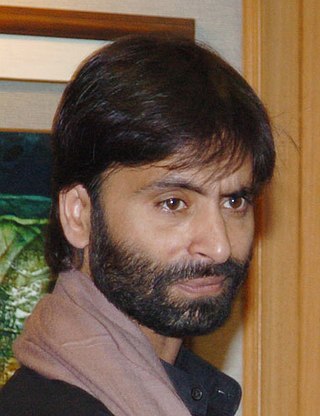
Yasin Malik is a Kashmiri separatist leader and former militant who advocates the separation of Kashmir from both India and Pakistan. He is the Chairman of the Jammu Kashmir Liberation Front, which originally spearheaded armed militancy in the Kashmir Valley. Malik renounced violence in 1994 and adopted peaceful methods to come to a settlement of the Kashmir conflict. In May 2022, Malik pleaded guilty to charges of criminal conspiracy and waging war against the state, and was sentenced to life imprisonment.

Maqbool Bhat, also spelt Maqbool Butt (1938–1984), was a Kashmiri pro-independence leader who went to Pakistan and founded the resistance group National Liberation Front (NLF), which was a precursor to the present day Jammu Kashmir Liberation Front (JKLF). He is also termed as the "Father of the Nation of Kashmir" Baba-e-Qaum, by the locals. Bhat carried out multiple attacks in Indian-administered Jammu and Kashmir. He was arrested and sentenced to double death sentence. He was hanged on 11 February 1984 in Tihar Jail in Delhi.

St. Joseph's Higher Secondary School Baramulla is a private school located in Baramulla, Jammu and Kashmir, India. The school has been upgraded to the status of a higher secondary school and has also started online education, the first in the Kashmir valley. St. Josephs School is located in the city of Baramulla. It has around 4,000 students and over 125 staff members.
In 1989, Rubaiya Sayeed, the daughter of the then Indian Home Minister Mufti Mohammad Sayeed, was kidnapped by Kashmiri separatist militants in Srinagar, the capital of Jammu and Kashmir. The kidnappers demanded the release of five jailed members of Jammu Kashmir Liberation Front (JKLF) in exchange for Sayeed's release. The Indian government headed by V. P. Singh of the Janata Dal party, with outside support from the BJP, agreed to the demands and induced the state government to release the jailed militants. In 2004, the JKLF admitted to having carried out the kidnapping, and the court case is ongoing. In July 2022, Rubaiya identified Yasin Malik, one of the key leaders of JKLF at that time, as one of her kidnappers.

Sajad Gani Lone is an Indian politician, and former Member of the Legislative Assembly elected from the Handwara constituency. He is the chairman of Jammu and Kashmir People's Conference.
Mohammad Abbas Ansari was a separatist political leader and a well known Shia Muslim scholar, reformer, preacher and cleric from Indian-administered Jammu and Kashmir. He was known for his religious lectures and as a Kashmiri separatist, ex-chairman of the All Parties Hurriyat Conference, also founder & chairman of the Ittihadul Muslimeen also known as Jammu & Kashmir Ittihadul Muslimeen (JKIM) a Kashmiri nationalist Shia separatist political party which aims for Shi'a–Sunni unity in Kashmir & independence of Jammu and Kashmir from India through peaceful struggle. He is considered a moderate and has called for an end to violence in that region. He is Succeeded by his son Maulana Masroor Abbas Ansari.

Hashim Qureshi is a pro-Kashmiri leader and one of the founding members of Jammu Kashmir Liberation Front (JKLF) and is now the Chairman of Jammu Kashmir Democratic Liberation Party (JKDLP), one of the main Kashmiri political organisations which strives to find a political solution to merge Kashmir with Pakistan through peaceful political activities.
Muhammad Ahsan Dar is a Kashmiri Islamist militant separatist leader from Jammu and Kashmir. He was the founder of an Islamist militant group called Ansarul Islam in mid-1980s, which later became the core of Hizbul Mujahideen. Formed in September 1989, Hizbul Mujahideen was an umbrella group of a dozen Islamist groups in the Kashmir Valley and was sponsored by Pakistan's Inter-Services Intelligence and Jamaat-e-Islami. Ahsan Dar served as the head of the united group for a few years, but was marginalised the Jamaat-e-Islami patron Syed Salahuddin. He later founded a new group called Muslim Mujahideen in 1992, which operated for a few years. It was eventually neutralised by Hizbul Mujahideen and Indian security forces, and Ahsan Dar retired from militancy.

Amanullah Khan was the founder of the Jammu and Kashmir Liberation Front (JKLF), a Kashmiri militant activist group that advocates independence for the entire Kashmir region. Khan's JKLF initiated the ongoing armed insurgency in Indian-administered Kashmir with backing from Pakistan's Inter-Services Intelligence, which lasted until Pakistan dropped its support of secular Kashmiri separatists in favour of pro-Pakistan Islamist groups, such as the Hizbul Mujahideen. In 1994, the JKLF in the Kashmir Valley, under the leadership of Yasin Malik, renounced militancy in favour of a political struggle. Amanullah Khan disagreed with the strategy, causing a split in the JKLF.

On 30 January 1971, an Indian Airlines domestic Fokker F27, also named "Ganga", flying from Srinagar Airport to the Jammu-Satwari Airport, was hijacked by two Kashmiri separatists belonging to the National Liberation Front. The hijackers were Hashim Qureshi and his cousin Ashraf Qureshi. The aircraft was flown to Lahore Airport in Pakistan where the passengers and the crew were released and the aircraft was burnt down.
Ashfaq Majeed Wani was the first Commander in Chief of the Jammu Kashmir Liberation Front, a militant Kashmiri-separatist group in Jammu and Kashmir, India. He was killed by Indian Paramilitary Forces in 1990 at the age of 24. He was allegedly involved in the kidnapping of Rubiya Sayed, daughter of Mufti Mohammed Sayeed, the then Home Minister of India.
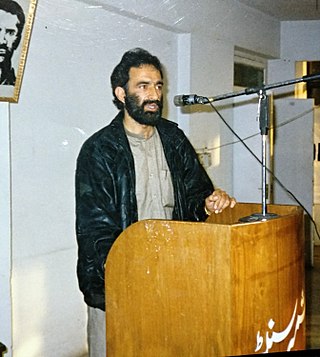
Abdul Majeed Dar was a former chief commander of the militant group Hizbul Mujahideen in Jammu & Kashmir till 2001. He later gave up violence and sought to restore peace in Kashmir.
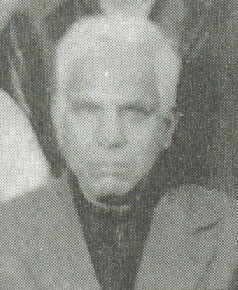
Neelkanth Ganjoo was an Indian high court judge based in Srinagar who was assassinated by Islamist-separatist militants.














